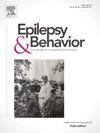Personality assessment inventory sex differences in people with epileptic and functional seizures
IF 2.3
3区 医学
Q2 BEHAVIORAL SCIENCES
引用次数: 0
Abstract
Objective
Previous research has shown that the Personality Assessment Inventory (PAI) is useful in differentiating individuals with functional seizures (FS) from those with epileptic seizures (ES). In these two groups, sex differences in PAI validity and clinical subscales have not been investigated. Elucidating sex differences could improve the understanding of how males and females experience FS or ES and may improve differential diagnosis and treatment planning.
Method
We examined sex differences across PAI scales, subscales, and validity profiles amongst adults with FS (n = 62) and ES (n = 55). Participants were evaluated and classified at the Johns Hopkins Hospital Epilepsy Monitoring Unit based on continuous video electroencephalography (cEEG) confirmed diagnoses. Among valid profiles, we conducted the following analyses: calculation of odds ratios (OR) and associated confidence intervals (CI) for each clinical, treatment, and interpersonal scale; logistic regression models to examine whether diagnostic status could be predicted by PAI scale elevations and sex; positive predictive values (PPV) and negative predictive values (NPV) to understand the diagnostic utility of scale and subscale elevations; and receiver operating characteristic (ROC) curves to determine the area under the curve (AUC) and identify PAI scales with the greatest capacity to distinguish FS presence/absence.
Results
There were no significant differences in validity scales between FS and ES groups, both in the combined sample and when stratifying by sex (p’s > 0.05). On a clinical scale level, FS females produced higher elevations on stress (STR) and somatic complaints (SOM) (OR = 4.17, OR = 6.95, p’s < 0.05), and FS males reported higher anxiety (ANX), anxiety-related disorders (ARD), and non-support (NON) (OR = 8.0, OR = 11.25, OR = 15.2, p’s < 0.05) than sex-matched ES patients. On a subscale level, FS females were more likely than ES females to have clinically elevated conversion (SOM-C) and somatization (SOM-S) scales (OR = 4.72, OR = 5.78, p’s < 0.05), and FS males were more likely than ES males to report clinically elevated SOM-C, physiological anxiety (ANX-P), and trauma-related distress (ARD-T) (OR = 10.53, OR = 9.52, OR = 9.52, p’s < 0.05). ROC findings revealed that SOM-C (AUC = 0.72) and ANX-P (AUC = 0.78) had the greatest AUCs for FS females and males, respectively. In the combined sex sample, FS patients were more likely than ES patients to endorse mildly elevated paranoia (PAR) and STR and clinically elevated SOM, depression (DEP), and ARD (ORs = 4.86, 3.52, 5.10, 3.01, 4.38, respectively, p’s < 0.05); when entering these scales in a logistic regression model, SOM was the best predictor of FS. However, overall classification rates did not exceed 80 % (PPV = 75.5 %, NPV = 65.5 %). Among subscales, the combined-sex FS cohort was more likely to endorse elevations on SOM-C, SOM-S, ANX-P, and ARD-T than the ES cohort (ORs = 5.24, 3.82, 4.38, 4.38, respectively, p’s < 0.05); when entering these scales in a logistic regression model, SOM-C was the best predictor of FS. Within the combined sex sample, SOM-C and STR had the highest AUCs (0.70 and 0.68, respectively).
Conclusions
Our findings indicate that males and females with FS are both more likely than those with ES to endorse higher conversion symptoms but otherwise have different characteristics. These differences might influence predisposition to the development of FS or perpetuation of symptoms and could be useful in determining optimal treatment approaches.
癫痫和功能性癫痫患者的人格评估清单性别差异
目的以往的研究表明,人格评估量表(PAI)可用于区分功能性癫痫发作(FS)和癫痫发作(ES)。在这两组中,尚未研究PAI效度和临床亚量表的性别差异。阐明性别差异可以提高对男性和女性如何经历FS或ES的理解,并可能改善鉴别诊断和治疗计划。方法研究了成人FS (n = 62)和ES (n = 55)的PAI量表、子量表和效度谱的性别差异。根据连续视频脑电图(cEEG)确诊,在约翰霍普金斯医院癫痫监测部门对参与者进行评估和分类。在有效的档案中,我们进行了以下分析:计算每个临床、治疗和人际量表的优势比(OR)和相关置信区间(CI);logistic回归模型检验PAI量表升高和性别是否可以预测诊断状态;阳性预测值(PPV)和阴性预测值(NPV)来了解量表和亚量表海拔的诊断效用;和受试者工作特征(ROC)曲线,以确定曲线下面积(AUC),并确定区分FS存在/不存在能力最大的PAI量表。结果FS组和ES组在联合样本和按性别分层时的效度量表均无显著差异(p 's >;0.05)。在临床量表水平上,FS女性在应激(STR)和躯体抱怨(SOM)上有较高的升高(OR = 4.17, OR = 6.95, p 's <;0.05), FS男性报告更高的焦虑(ANX)、焦虑相关障碍(ARD)和不支持(NON) (OR = 8.0, OR = 11.25, OR = 15.2, p 's <;0.05)高于性别匹配的ES患者。在亚量表水平上,FS女性比ES女性更有可能出现临床转化(SOM-C)和躯体化(SOM-S)量表升高(OR = 4.72, OR = 5.78, p 's <;0.05), FS男性比ES男性更容易报告临床SOM-C升高、生理性焦虑(anxp)和创伤相关应激(ad - t) (OR = 10.53, OR = 9.52, OR = 9.52, p 's <;0.05)。ROC结果显示,SOM-C (AUC = 0.72)和ax - p (AUC = 0.78)分别在FS女性和男性中具有最大的AUC。在综合性别样本中,FS患者比ES患者更有可能支持轻度升高的偏执(PAR)和STR,以及临床升高的SOM、抑郁(DEP)和ARD (or = 4.86、3.52、5.10、3.01、4.38,p 's <;0.05);当在逻辑回归模型中输入这些量表时,SOM是FS的最佳预测因子。但总体分类率未超过80% (PPV = 75.5%, NPV = 65.5%)。在各分量表中,合并性别FS组较ES组更有可能认可SOM-C、SOM-S、anxp和ARD-T的升高(or分别为5.24、3.82、4.38、4.38,p 's <;0.05);在逻辑回归模型中输入这些量表时,SOM-C是FS的最佳预测因子。在合并性别样本中,SOM-C和STR的auc最高(分别为0.70和0.68)。结论男性和女性FS患者均比ES患者更容易出现较高的转化症状,但在其他方面有不同的特点。这些差异可能会影响FS发展的易感性或症状的延续,并可用于确定最佳治疗方法。
本文章由计算机程序翻译,如有差异,请以英文原文为准。
求助全文
约1分钟内获得全文
求助全文
来源期刊

Epilepsy & Behavior
医学-行为科学
CiteScore
5.40
自引率
15.40%
发文量
385
审稿时长
43 days
期刊介绍:
Epilepsy & Behavior is the fastest-growing international journal uniquely devoted to the rapid dissemination of the most current information available on the behavioral aspects of seizures and epilepsy.
Epilepsy & Behavior presents original peer-reviewed articles based on laboratory and clinical research. Topics are drawn from a variety of fields, including clinical neurology, neurosurgery, neuropsychiatry, neuropsychology, neurophysiology, neuropharmacology, and neuroimaging.
From September 2012 Epilepsy & Behavior stopped accepting Case Reports for publication in the journal. From this date authors who submit to Epilepsy & Behavior will be offered a transfer or asked to resubmit their Case Reports to its new sister journal, Epilepsy & Behavior Case Reports.
 求助内容:
求助内容: 应助结果提醒方式:
应助结果提醒方式:


